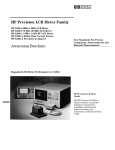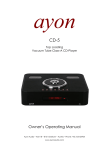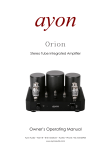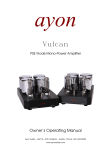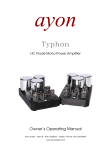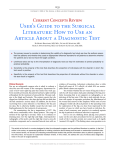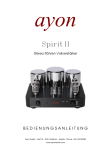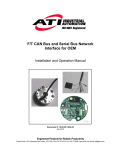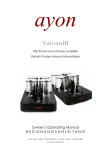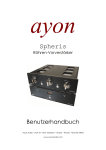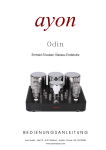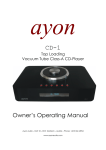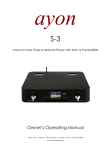Download Ayon Triton Owner`s manual
Transcript
Triton Stereo Tube Integrated Amplifier Owner’s Operating Manual Ayon Audio – Hart 18 – 8101 Gratkorn – Austria – Phone: +43 3124 24954 www.ayonaudio.com WARNING PRECAUTION AND SAFETY To prevent shock or fire hazard do not open the unit or expose to rain or moisture. Refer all service to Ayon Audio Company or an Ayon authorized service facility. There are no user serviceable parts inside the Triton. Refer all internal service, updates, or modifications to qualified service personnel. High voltage is present inside operating Triton. Do not remove bottom plate or insert any objects through openings in the case. OPERATING VOLTAGE The operating voltage is factory set for the destination country and is not user adjustable. Unauthorized attempts to modify the operating voltage may damage the unit and will void the manufacturer warranty. FUSE The AC power line fuse is located in a snap-out receptacle on the underside of the power inlet (rear panel). The correct value of Slow-Blow fuse is 5A. Do not replace the fuse with a higher than indicated. Disconnect the power cord before changing fuse. A blown fuse in your unit can be an indication of a serious problem. If a replacement fuse fails as well, no further attempts should be undertaken. Please contact the factory for professional service. Serial Number: Voltage: Distributor: 2 Ayon Audio – Hart 18 – 8101 Gratkorn – Austria – Phone: +43 3124 24954 www.ayonaudio.com INTRODUCTION Thank you for your purchase of the Ayon Triton power amplifier. Please read this owner’s manual to obtain the full benefit of the Triton amplifier in your system. This manual provides you with necessary safety information and operation procedures for this unit. With this amplifier, you have entered into the world of exclusive design which will give you great satisfaction and privilege of enjoying the advanced technology of Ayon Audio products. It is designed to serve as a high standard of truthful real musical performance. The care in engineering and manufacturing of this product anticipates a long time of enjoyment. We also encourage you to enlist the aid of the dealer from whom you purchased this Ayon Triton amplifier. Your dealer is an excellent source of information on compatibility, installation, and troubleshooting, and should be capable of helping ensure that your overall music system provides you with maximum performance and satisfaction. WHY VACUUM TUBES The output level of studio microphones under typical recording conditions contain peaks far in excess of what VU meters display. Everyone knows that, but the peaks, as measured with an oscilloscope, are really quite high, easily exceeding 1 volt! The tube or transistor used in a condenser microphone, or in a microphone preamplifier, often will be driven into severe overload by these peaks. The peaks are short, so the sound isn't grossly distorted-sounding; but the distorted peaks do affect what we hear. All preamps (and condenser microphone electronics) are overloaded by these peaks, but tubes handle it differently than solid-state devices. When transistors overload (in a discrete circuit or in an OP amp), the dominant distortion product is the third harmonic. The third harmonic "produces a sound many musicians refer to as blanketed”. Instead of making the tone fuller, a strong third actually makes the tone thin and hard. On the other hand, with tubes (particularly triodes) the dominant distortion product is the second harmonic: “Musically the second is an octave above the fundamental and is almost inaudible, yet it adds body to the sound, making it fuller”. Tubes sound better because their distortion products are more musical. Tubes provide a more appropriate load to transducers. Those are the fundamental reasons why tubes simply sound better. CAUTION & HANDLING TIPS 1. Always be sure your hands are clean and free of any dirt or oil before carrying your Ayon Triton. Carry the amplifier with both hands by gripping its side. 2. Never hold the face plate against your clothing as coarse materials, stitching, belts and the rivets from denim pants can mar the surfaces. 3. Never put any objects directly on top of the unit. 4. Use a soft cloth with non-abrasive cleaning product to clean your amplifier. 5. Gloves or a soft cloth will prevent "fingerprinting" of the tubes during their installation. Do not touch the tubes without the use of a cotton glove or soft cloth. 6. Take care of the precision toggle switch selectors on the rear when moving or transporting the Triton. 7. When the unit is on, be careful not to touch the vacuum tubes. Vacuum tubes get HOT. 8. The unit should be put on an adequate ventilated place; Allow clearance of a couple inches in all directions so as to allow air to flow. Do not place the amplifier directly on a carpet or any surface that will block air circulation under the amp. 9. Avoid placing the unit indirect sunlight or near sources of damp. 10. Never touch power plug with wet hands. 11. Disconnect from power before removing bottom plate is mandatory. 12. Please pull out the AC power cord by the plug instead of dragging it. 13. For best performance, place the Triton on a solid, non-resonant shelf that will minimize vibration. 3 Ayon Audio – Hart 18 – 8101 Gratkorn – Austria – Phone: +43 3124 24954 www.ayonaudio.com CONTENTS OPEN CARTON – UNPACKING THE TRITON ACCESSORIES OPERATION YOUR NEW TRITON 1. Installation of tubes 2. Connecting 3. Turn ON procedure 4. Turn OFF procedure 5. Security caution in operation 6. Bias adjustment 7. Triode / Pentode switch 8. Power tube – protection board 9. Troubleshooting 10. How to operate remote control BREAK-IN PERIOD SPECIFICATION VACUUM TUBES WARRANTY AND SERVICE 4 Ayon Audio – Hart 18 – 8101 Gratkorn – Austria – Phone: +43 3124 24954 www.ayonaudio.com OPEN CARTON - UNPACKING THE TRITON Inspect your amplifier for any shipping damage and call your dealer immediately if any is found. Note: Do not plug your amplifier into an AC outlet if you find shipping damage. To avoid damaging the vacuum tubes please don’t turn the cardboard box upside down. Open the box and carefully take out the vacuum tubes and then the amplifier. The amplifier is very heavy! We advise saving all packing materials so that the unit can be easily and safely shipped if the need arises. KT88 9 13 11 10 12 V2 V3 V6 V7 KT88 KT88 KT88 KT88 8 V1 KT88 T V4 V5 KT88 KT88 V8 T P 12AU7 6 Left 7 KT88 P 12AU7 Right 12AU7 12AU7 12AU7 12AU7 Volume Input Selector ayon 2 1 Triode L Triode R Line 1 Line 2 Line 3 Line 4 Direct Mute 3 4 Stereo Integrated Amplifier 5 front view (1) volume control knob (2) remote window eye (3) red backlit ayon logo (-) mute LED indicator (4) source selector knob with LED indicator (5) feet (-) left & right triode LED indicator (6) T/P changeover switch (7) vacuum tube socket – 12AU7 (8) vacuum tube socket – KT88 (9) vacuum power tube – KT88 (10)output transformer – left (11)power transformer – high voltage (12)power transformer – filament, low voltage (13)output transformer – right 5 Ayon Audio – Hart 18 – 8101 Gratkorn – Austria – Phone: +43 3124 24954 www.ayonaudio.com ACCESSORIES Provided with the Ayon Triton amplifier are the following accessories: 8 x KT88 power tubes, 6 x 12AU7 signal - driver tubes, 1 x AC power cord, 1 x remote control, 1 x owner’s operating manual, OPERATION 1. Installing the vacuum tubes Please remove the vacuum tubes and the Triton from box and place the Triton on a firm, level surface. Insert the vacuum tubes in accordance with the designated tube numbers into their relative assigned sockets. Note: It is very important to insert the tubes in the correct location. Important: Pay close attention to the direction of socket pins. If the direction is wrong and you force the tube, damage to the socket pins will occur. NEVER FORCE A VACUUM TUBE INTO PLACE. Tube should glide right in and have to fit tighten (good pin contact). Ensure that all of the tubes are fully seated in their sockets. KT88 KT88 12AU7 ECC82 1Pins in all 9 pins 1st pin in all 8 pins the tubes 6 Ayon Audio – Hart 18 – 8101 Gratkorn – Austria – Phone: +43 3124 24954 www.ayonaudio.com 2. Connecting To assure reliable operation always turn the Triton OFF while making or changing input or speaker connections. No connections should be made while the amplifier is ON. Rear panel All input and output connectors are clearly marked on the rear panel. LOUDSPEAKER: There are three sets of gold speaker output terminals at the rear panel: Left out, common, 4, 8, ohm, Right out, common, 4, 8, ohm. Connect the speaker input terminals to corresponding speaker output terminals at the rear panel according to the impedance of the speaker with high quality audio cord. Pay close attention to proper matching of positive and negative and left and right channels. a.) INPUT: LINE1, LINE2, LINE3 and LINE4 connect your device with a high quality RCA lead. You can then select any source input for LINE1, LINE2, LINE3 & LINE4. Rotate input selector accordingly. b.) The Triton is equipped with a Direct In. This connection allows the Triton to be used as a stereo amplifier connected to a separate Pre-Amplifier. c.) The Triton is also equipped with a source output (Pre-Out), an output for connection to a sub-woofer, headphone or other device. d.) TP: Test points for bias e.) Bias: Regulation of static working point bias current Line 1 Line 2 Line 3 Line 4 Pre Out Direct In 8 Ohm 4 Ohm Common Bias 5 Bias 6 Bias 1 Bias 2 Left TP 5 TP 1 Source TP 6 TP 2 TP 7 TP 3 TP 8 TP 4 Right Ayon - Austria ayonaudio.com Bias 8 Serial No. 0 Bias 7 Bias 4 Bias 3 rear panel (1)source input (4x line & direct in ) and source output (Pre out) (2)speaker out ( Common, 4 Ohm or 8 Ohm ) (3)potentiometer for bias adjustment (4)test point for bias check (5)power inlet - with fuse (6)power switch (7)phase indicating lamp – 230V Schuko only (8)ground switch – for power amp operation only 7 Ayon Audio – Hart 18 – 8101 Gratkorn – Austria – Phone: +43 3124 24954 www.ayonaudio.com Power Phase ~AC In Ground The power connection is located at the rear panel. Plug the AC power cord into receptacle. Power switch off = “0” - Power switch on = “|”. Note: In case the Triton is used as a pure power amplifier and there is a hum loop (hum audible from more than a few inches from the loudspeakers) flip the grounded/ungrounded switch. It is recommended that you do not use a power conditioner as it may limit the current available to the amplifier. Note: when the phase control indicator glows red the Phase polarity is wrong. Reverse the AC plug! (This function applies for 230V and Schuko plug version only) 3. Turn ON procedure When all sources are connected properly, turn down the volume to minimum, switch on the power - the Ayon-logo glows; it will go through a gentle power-on sequence first. Please wait for min. 60 seconds before turning the volume up. After 60 seconds, the unit is operational. Now you can increase the volume via the volume control. Follow this procedure each time you turn your Triton on. Some preamplifiers and sources can generate dangerous transients that can damage loudspeakers. To avoid letting dangerous transients reach your loudspeakers turn your system on in the following order: 1) Turn on all sources (CD, tuner, etc.) that you will be using. 2) Turn on the preamplifier. (If you use your Triton as a pure power amp) 3) Wait until preamp has stabilized. 4) Power up Triton amplifier. 5) Select listening source and play music. Note: The Triton is using a big power supply with large high voltage capacitor storage, during power ON an electrical capacitor charging noise – hum may be heard especially when the amp was turn off for a while. This is not cause for alarm, it is normal. 4. Turn OFF procedure When powering down your system, always turn the amplifier off first. The unit can be turned off at any time (even while playing). Imortant: If the Triton was turned OFF even for a short period of time, you should wait at least 2 minutes before turning it back ON. Do not turn it ON then OFF and then ON again in quick succession. This precaution will minimize the stress (high voltages) on internal components. Follow this procedure each time you turn your Triton OFF / ON. 5. Security caution in operation A. Handle the Triton with respect, it is heavy. B. Insert the vacuum tubes in accordance with the designated tube numbers into their relative assigned sockets. Important: Pay close attention to the direction of socket pins NEVER FORCE A VACUUM TUBE INTO PLACE. Tube should glide right in. If the direction is wrong and you force the tube, damage to the socket pins will occur. C. Turn volume control down to the minimum position. Rotate input selector knob to the corresponding position for input device connected. D. Check your speaker connections! DO NOT OPERATE AMPLIFIER WITHOUT INSURING THAT SPEAKERS ARE CONNECTED TO THE AMPLIFIER. DAMAGE WILL OCCUR. E. Do not switch from Pentode to Triode mode during operation of the amplifier. Turn amplifier off and then perform the switch! 8 Ayon Audio – Hart 18 – 8101 Gratkorn – Austria – Phone: +43 3124 24954 www.ayonaudio.com F. Insure that the Ayon logo, located on the front panel of the Triton, illuminates . G. The Triton amplifier SHOULD NOT BE LEFT RUNNING WHEN NOT IN USE. If you will not be listening to the amplifier for more than an hour, it is advised that the amplifier be turned off. Unlike solid state amplifiers, tube amplifiers should be shut down when not being used. This will greatly prolong tube life. H. It is normal for vacuum tube equipment to runs very warm if used for prolonged periods. I. Do not use a speaker with impedance lower than 2 ohms on either of the outputs. Note: NEVER REMOVE THE BOTTOM PLATE OF THE TRITON BEFORE UNPLUGGING THE UNIT FROM THE WALL! 6. Bias adjustment – important! The output power tubes need to be “biased” with a grid voltage that controls the flow of electrical current through the tube. Tube biasing on the amplifier has been designed to be both simple and effective. The bias is set individually for each tube so that the correct operating point is assured. An added benefit to this approach is that, should a tube fail prematurely, the single tube can be replaced without having to purchase a matched set. Use the following procedure to set the tube bias: Adjust the Bias via potentiometer: Bias1, Bias2, Bias3, Bias4, Bias5, Bias6, Bias7 and Bias8. Place the red terminal of the digital multi-meter to the corresponding TP1, TP2, TP3, TP4, TP5, TP6, TP7 and TP8. Place the black terminal of the digital multi-meter to the Common (negative) terminal - ohm speaker-out of the amplifier. The current value will be displayed of the electrical current running through the KT88 tube. The correct value should be approximately 450mV. Important: Please check the bias voltage several times during the first 20 minutes of warm up and adjust if necessary to the recommended value. Important notice for new tubes or new amplifier: When using the amplifier for the first time or after any exchange of the KT88 tubes, the bias voltage for the KT88 tubes should be set to around 250mV and the amplifier should be run with this value for some hours to allow for a smooth initial run-in of the tubes. After completion of this "warm up" phase, the bias should be slowly increased towards the optimal value of 450mV. A new KT88 tube is known for its tendency to let the bias rise slowly but continuously. 9 Ayon Audio – Hart 18 – 8101 Gratkorn – Austria – Phone: +43 3124 24954 www.ayonaudio.com KT88 KT88 KT88 KT88 KT88 KT88 KT88 KT88 OFF ON Line 1 Line 2 Line 3 Line 4 Pre Out Direct In 8 Ohm 4 Ohm Common Bias 5 Bias 6 Bias 1 Bias 2 Left TP 5 TP 1 Source TP 6 TP 2 Power Phase ~AC In Ground ¦? TP 7 TP 3 TP 8 TP 4 2 00K 20K 2K Right 2M 20M 2 00 200M DC A 200m 2m Ayon - Austria ayonaudio.com Serial No. 0 Bias 8 Bias 7 Bias 4 Bias 3 DC 2 20m V 20 200m 200 20 10 00 20 750 200m 200 20m 20 2m AC A 2 2 0¦? AC V 200m 2 ¦? hFE 2 00n 2n 20n F CX P NP F USE D UNFUSE D E B NPN C E E B C E DC100 0V AC75 0V MAX 0.2 A MAX ! MAX 20A A MAX 500V C OM V¦? bias adjustment 7. Triode / Pentode switch (T/P) for left and right channel separate The output transformer of a tube amplifier acts as the electrical interface between the very different impedances of the loudspeaker and the tube circuitry. There are two fundamental ways that the output transformer can be connected to the tube circuit. 1) Triode operation – the lowest and most advanced level of distortion is achieved but at the expense of output power. In the case of the Triton, its power level in triode is high enough that it will likely provide plenty of power for almost any speaker load. 2) Pentode operation – for loudspeakers that demand very high levels of power, Pentode-ultralinear should provide excellent sound and plenty of power. The triode/pentode switch allows the user to operate Triton in either of the two modes. In general, the sonic differences are subtle but for a given loudspeaker one mode is likely to sound better than the other. There is a complex relationship between the output transformer and the crossover network so try both and see which one works best in your system. 10 Ayon Audio – Hart 18 – 8101 Gratkorn – Austria – Phone: +43 3124 24954 www.ayonaudio.com 8. Power tube – protection board In order to protect the output level to the tubes, this unit is equipped with a special protection power tube circuit to detect over currents and voltages. When an over current or DC-input from the sources is detected or a power tube itself has a problem, the protection circuit will shut off the output tube’s current and continue to do so until the power is switched off. The protection circuit may also activate when it is connected to a speaker with lower impedance than allowed, resulting in a large input that creates an over current. When the protection circuit has activated (cut off), then turn off, wait 2 minutes and then turn the power back on. Should the protection circuit continue to activate even after removing the cause (power tubes, signal tubes or DC input source signal) of the over current, please contact your dealer. Note: When a large signal is input while a protection circuit is functioning, a slight electrical noise from the current may be heard. This is not cause for alarm. This is the circuit maintaining its protection of the output tubes. 9. Troubleshooting – in general If you experience any problem with this unit, please take the time to look through this chart and see if you can solve the problem yourself before you call your dealer. No power: Check the connection to the AC power supply. Check and make sure the AC source is not a switched outlet and that, if it is, the switch is turned on. Insert the power cord into the AC inlet of this unit. There is no sound: Press the power switch to turn on the unit, your external pre-amplifier (if any), and disc player etc. Make sure a signal is output from a pre-amplifier or a CD-player etc. Check if the pre-amplifier, speakers and source components are secure connected. Select input setting of the pre-amplifier etc. correctly. Adjust the pre-amplifier volume. The protection circuit is in operation when there is no Bias on all TP’s (tubes) readable. Turn off the unit and solve the cause of problem. Power tube will not bias: If the meter provides a reading but the tube will not bias correctly, the tube is probably bad. 10. How to operate remote control ( RC ) ayon remote control 11 Ayon Audio – Hart 18 – 8101 Gratkorn – Austria – Phone: +43 3124 24954 www.ayonaudio.com A. Volume: Use these buttons to adjust the volume. B. Mute: Use this button to mute the sound. Battery Installation You will require a small size Allen Hex Wrench, provided. 1) On the top and bottom of the remote you will see 4 hex screws on each end of the remote. Using the provided Allen Wrench, remove the 2 top UPPER section hex screws only. Carefully separate the top panel of the remote control from the lower panel of the remote control. Handle carefully as do not damage the signal diode. After separation the top panel, insert 2 x AAA batteries, observes the polarity! 2) Test it and then re-assemble. Remote Control Operation Point the remote control emitter diode to the front of the amplifier. To increase the volume, depress the right button with the upward facing arrow. To decrease the volume, depress the left button with the downward facing arrow. The mute button is located above the volume control buttons. When the remote control range is has become shortened, replace the batteries. Always replace the batteries as a new PAIR! Check Voltages and DO NOT USE RECHARGEABLE Batteries. Use a dry soft cloth to clean the remote control and battery spring when replacing with new batteries. Keep remote control, dry, out of direct sunlight or heat. DO NOT DROP! BREAK-IN PERIOD Your new Ayon Audio electronics Triton tube amplifier has an initial break–in period. The unit will not perform to its full sonic potential when first installed in your system. This is partially due to a residual polarization of the dielectric materials used in the PCB, like resistors, capacitors, chokes, transformers and internal wiring. As music is played through the unit, the electrical signal will gradually anneal these materials. Only after the break-in period will the full performance of your Ayon Audio Triton is fully realized. The break-in process will occur naturally as music is played through the system. The recommended break-in procedure is as follows: ° Initial warm-up: five to eight hours of quiet music. ° Extended break- in: 30 to 50 hours of mid volume level and dynamic source material. Note: For best results, do not burn–in your Triton continuously for more than 6- 8 hours. Give the unit a break before you turn it on again. Burn-in the Triton without any stress and be sure to use the system, “Normally”. During the break-in period, the sonic properties of your unit may undergo several gradual shifts as the various components break–in at different rates. It is therefore suggested that the fine tuning of the system be delayed until after the break–in period is completed. However, during the final phases of the break–in period, the sonic image will open up, the sound stage will bloom to perfection, the bass control and impact will increase and the overall sound will have a more involving sound stage presentation. 12 Ayon Audio – Hart 18 – 8101 Gratkorn – Austria – Phone: +43 3124 24954 www.ayonaudio.com SPECIFICATION Amplifier Class of Operation Tube Complement Load Impedance Bandwidth Output Power / Pentode mode Output Power / Triode mode Peak Output Power / Pentode mode Frequency Response Frequency Response Input Impedance at 1 kHz Input sensitivity ( full power ) S/N ratio at full power Hum NFB Volume Control Remote Control Inputs & Outputs Dimensions (WxDxH) cm Shipping dimensions (WxDxH) cm Weight Shipping weight Ayon Triton Triode or Pentode mode 8x KT88, 6x 12AU7 4 & 8 Ohms 8Hz-70kHz 2 x 100 Watt 2 x 60 Watt 2 x 140 Watt 15 Hz - 35 kHz / 0 dB 10 Hz - 60 kHz / -2.5 dB 100K Ohm 260mV 98 dB 0,003 V 0dB Potentiometer Yes 4 x Line IN, 1 x Direct IN, 1 x Pre Out 50x40x25 cm 78x68x53 cm 44 kg 55 kg Specifications subject to change without notice VACUUM TUBES Ayon Audio strongly discourages changing tubes (tube rolling) for the purpose of “improving sonic performance”. Tubes of the same part number from different manufacturer’s and lots generally vary considerably in many operating parameters. The Triton has been sonically and precisely optimized for the tubes installed at the factory in Austria, by Ayon Audio. The KT88 and 12AU7 tubes are highly selected and matched tubes by our experts at Ayon Audio. The original signal tubes will provide for many years of excellent audio performance. Tube Life Expectancy When tubes are new they are at slightly greater risk of going bad during there break in period. This is called infant mortality. After the break in time period the tubes will stabilize and last for the several thousand hours of operation unless traumatized by being jarred or dropped. For maximum audio quality however we recommend replacing the tubes after 3000 hrs of operation. 13 Ayon Audio – Hart 18 – 8101 Gratkorn – Austria – Phone: +43 3124 24954 www.ayonaudio.com WARRANTY AND SERVICE LIMITED WARRANTY Ayon Audio electronic components are warranted by the manufacturer to be free of defects in materials production for a period of 3 years (except all kinds of signal, rectifier and power tubes) from the date of purchase. Under this warranty defects are repaired free of charge. The purchaser is responsible for transportation from his location to the original sales agent, national distributor, or international distributor, whoever is closest. This warranty applies to the original purchaser only, and it is non-transferable to subsequent purchasers within the original 3 year period. Contact your dealer or Ayon Audio for commercial warranty policies. Requests for repair under this warranty must be accompanied by an unaltered copy of the original purchase receipt. IN THE EVENT OF A PROBLEM In the unlikely event of a problem with Ayon electronic, if any replacement part is required first contact your Ayon dealer. He will ensure continuous operation at the highest level of performance. The defective parts must then be returned to the factory for inspection to determine the status of the warranty claim. This on-site replacement of the parts eliminates the time and expense of shipping the entire Amplifiers to the factory for repair. All warranty claims must be made through an authorized Ayon dealer or distributor. CONDITIONS This warranty is subject to the following conditions and limitations. The warranty is void and inapplicable if the product has been used or handled other than in accordance with the instructions in the owner’s manual, abused or misused, electric shorts from lightings or overloaded wall power outlet, the serial identification plate and serial number has been removed from the Amplifiers, damaged by accident or neglect or in being transported or the defect is due to the product being repaired or tampered with by anyone other than Ayon Audio, or an authorized party. Ayon reserves the right to modify the design of any product without obligation to purchasers of previously manufactured products and to change the price or specifications of any product without notice or obligation to any person. ayon® is a registered trademark 14 Ayon Audio – Hart 18 – 8101 Gratkorn – Austria – Phone: +43 3124 24954 www.ayonaudio.com














